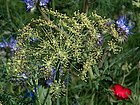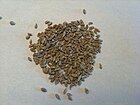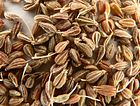Note: This is a project under development. The articles on this wiki are just being initiated and broadly incomplete. You can Help creating new pages.
Pimpinella anisum - Shatapushpa
Pimpinella anisum is an annual herb in the celery family Apiaceae. It is the sole species of the genus Anethum. It is mainly used in digestive disorders. Fresh and dried dill leaves are widely used as herbs in Europe and central Asia.
Contents
- 1 Uses
- 2 Parts Used
- 3 Chemical Composition
- 4 Common names
- 5 Properties
- 6 Habit
- 7 Identification
- 8 List of Ayurvedic medicine in which the herb is used
- 9 Where to get the saplings
- 10 Mode of Propagation
- 11 How to plant/cultivate
- 12 Commonly seen growing in areas
- 13 Photo Gallery
- 14 References
- 15 External Links
Uses
Asthma, whooping couch, coughs, pectoral affections, indigestion, colic, nausea, infestations of lice, scabies
Parts Used
Chemical Composition
The main constituents of he oil obtained from dried fruits were trans-a nethole (93.9%) and estragole (2.4%). The olfactorially valuable constituents that were found with concentration higher than 0.06% were (E)-methyeugenol, α-cuparene, α-himachalene, β-bisabolene, p-anisaldehyde and cis-anethole[1]
Common names
| Language | Common name |
|---|---|
| Kannada | |
| Hindi | Choti saunf, Patli saunf |
| Malayalam | |
| Tamil | |
| Telugu | |
| Marathi | NA |
| Gujarathi | NA |
| Punjabi | NA |
| Kashmiri | NA |
| Sanskrit | |
| English | Sweet cumin, Aniseed |
Properties
Reference: Dravya - Substance, Rasa - Taste, Guna - Qualities, Veerya - Potency, Vipaka - Post-digesion effect, Karma - Pharmacological activity, Prabhava - Therepeutics.
Dravya
Rasa
Tikta (Bitter), Katu (Pungent)
Guna
Laghu (Light), Tikshna (Sharp)
Veerya
Ushna (Hot)
Vipaka
Katu (Pungent)
Karma
Kapha, Vata
Prabhava
Habit
Identification
Leaf
| Kind | Shape | Feature |
|---|---|---|
| Simple | heteromorphic | Petioles 2–5 cm; blade reniform or broad-ovate, 1–3 × 1.2–2.8 cm, puberulent along veins, margin serrate |
Flower
| Type | Size | Color and composition | Stamen | More information |
|---|---|---|---|---|
| Unisexual | 2-4cm long | Yellow | 5-10 | Bracteoles 1 or 2 or absent, linear, 2–3 mm; umbellules 5–10 mm across, ca. 10-flowered |
Fruit
| Type | Size | Mass | Appearance | Seeds | More information |
|---|---|---|---|---|---|
| oblong-ovoid | 3–5 × 2–2.5 mm | vittae 2–4 in each furrow, 4–8 on commissure | Densely appressed setose-hairy | many | {{{6}}} |
Other features
List of Ayurvedic medicine in which the herb is used
Where to get the saplings
Mode of Propagation
How to plant/cultivate
Succeeds in ordinary garden soil but prefers a fairly rich warm well-drained light soil in a sunny position[3]
Commonly seen growing in areas
Tall grasslands, Meadows, Tropical area.
Photo Gallery
References
External Links
- Ayurvedic Herbs known to be helpful to treat Asthma
- Ayurvedic Herbs known to be helpful to treat whooping couch
- Ayurvedic Herbs known to be helpful to treat coughs
- Ayurvedic Herbs known to be helpful to treat pectoral affections
- Ayurvedic Herbs known to be helpful to treat indigestion
- Ayurvedic Herbs known to be helpful to treat colic
- Ayurvedic Herbs known to be helpful to treat nausea
- Ayurvedic Herbs known to be helpful to treat infestations of lice
- Ayurvedic Herbs known to be helpful to treat scabies
- Herbs with Leaves used in medicine
- Herbs with Seeds used in medicine
- Herbs with common name in Hindi
- Herbs with common name in English
- Habit - Herb
- Index of Plants which can be propagated by Seeds
- Index of Plants which can be propagated by Cuttings
- Herbs that are commonly seen in the region of Tall grasslands
- Herbs that are commonly seen in the region of Meadows
- Herbs that are commonly seen in the region of Tropical area
- Herbs
- Apiaceae




